PoW vs PoS is a battle of two different methods of proof-of-work. Pow, or proof-of-work, is a method of securing a cryptocurrency network that requires miners to solve complex mathematical problems in order to add blocks to the blockchain. Pos, or proof-of-stake, is a method of security for a crypto network that allows users to stake their coins in order to validate transactions and add blocks to the blockchain.
Some people swear by using the pow function, while others prefer the pos function. So which one is the best?
Let’s, with Cove Markets explore more.
What exactly is PoW?
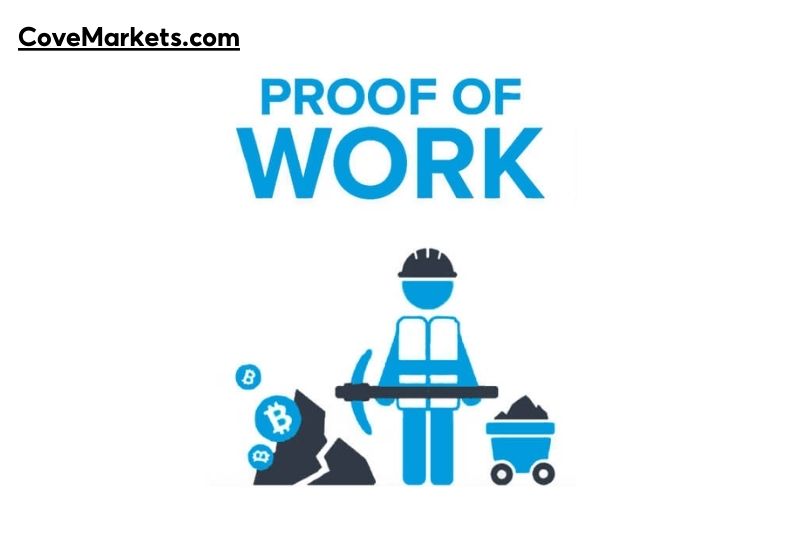
PoW, or proof of work, is a specific protocol designed to combat cyber-attacks such as DDoS (distributed denial-of-service attacks), which can deplete the resources of a computer stem by sending numerous bogus requests. It employs a trustless and decentralized consensus system.
PoW is a decentralized system that operates without the need for a centralized authority. The PoW consensus process can validate transactions without the involvement of a third party. PoW makes double-spending harder by demonstrating that each user has performed several computations. Many other blockchain projects that have copied the original Bitcoin code use the Proof of Work paradigm.
Pros
- Some important advantages/benefits of Proof of Work include:
- Proof-of-Work was created to prevent double-spending.
- It is one of the most secure ways to reach a consensus.
- PoW-based cryptos have higher mining power and are more secure.
- In a standard PoW scheme, mining earns rewards.
- Work proof is random but fair.
Cons
- Mining necessitates the use of incredibly powerful hardware.
- Not accessible to all market participants.
- Energy usage is out of control as a result of the exceptionally high mining participation.
- The vast majority of mining pools are run by a single entity.
- The PoW model is vulnerable to 51% attacks.
What exactly is PoS?
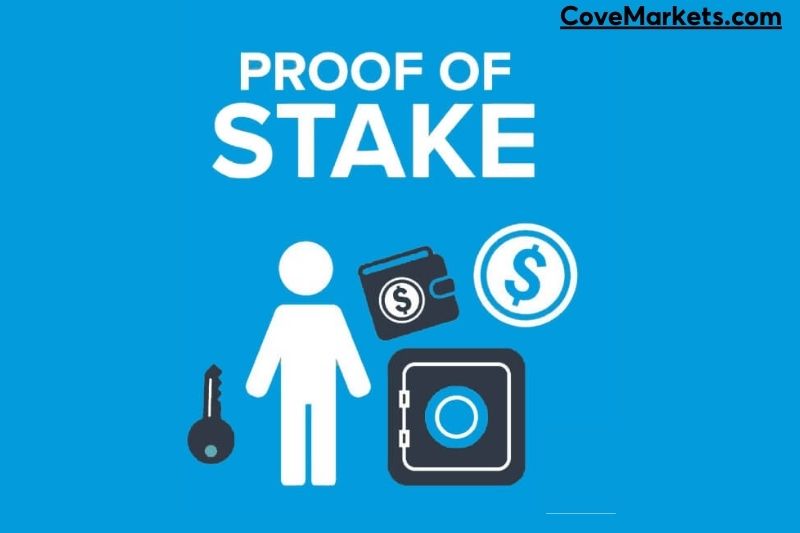
Proof of stake (PoS) is a sort of consensus technique used to validate blockchain transactions. It functions by allowing bitcoin holders to stake their coins. This provides them the authority to validate and add new blocks of transactions to the blockchain.
As an alternative consensus mechanism, the Proof of Stake model exists. This protocol, which replaces miners with stakes, is used by only a few coins. The system chooses one of these stakeholders to publish the next block. In 2012, two engineers named Scott Nadal and Sunny King built PoS after spotting faults in PoW. The PoS paradigm does not have a problem with limited scalability or requiring a lot of electricity.
Pros
- The PoS technique is immune to 51% of attacks.
- Proof-of-stake does not require expensive processing hardware.
- Transactions are quicker and less expensive.
- In the case of PoS, processing consumes little energy.
- In the PoS concept, stakes serve as a financial motive.
Cons
- PoS models have yet to be applied on a complex blockchain.
- Controlling the network is simply because it is based on capital.
- Many PoW benefits, like mining rewards, are unavailable to PoS.
- Double-spending and other centralized threats are executable.
- PoS has governance issues, which means that users with more tokens can change the network’s regulations.
What exactly is Staking?

Validators set aside monies and put them in a smart contract. This is referred to as the staking process. Whoever has the most to lose may be picked to verify transactions and build blocks. The forged blocks are added to the blockchain. Even if the principle of validity is similar, not all pos coins follow the same set of standards. Every qualifying validator market participant receives monetary compensation based on their ownership.
How Does PoS Work?

IPS is a “perfect” solution for scaling concerns inside the PoW method, in theory. Ethereum 2.0 will be entirely proof-of-stake. As a result, it will handle its own transactions, NFT transactions, and smart contract transactions by using computing power. A strong computer system and a large enough wallet are required. It improves their chances of receiving a proof-of-stake payout.
The PoS model is in charge of ensuring the integrity of a blockchain. It also ensures that cryptocurrency users cannot create coins without first earning them.
The following steps comprise the PoS consensus mechanism concept:
- Step 1. Users who hold native tokens of a blockchain safely keep all or a portion of them in staking pools.
- Step 2. The algorithm selects the next validator in line at random.
- Step 3 The selected validator must propose a block and the number of transactions contained within it.
- Step 4. The proposed transaction is approved and verified by the other participants.
- Step 5. The blockchain is updated with a new block.
- Step 6. The chosen validator receives a transaction fee.
How Does PoW Work?
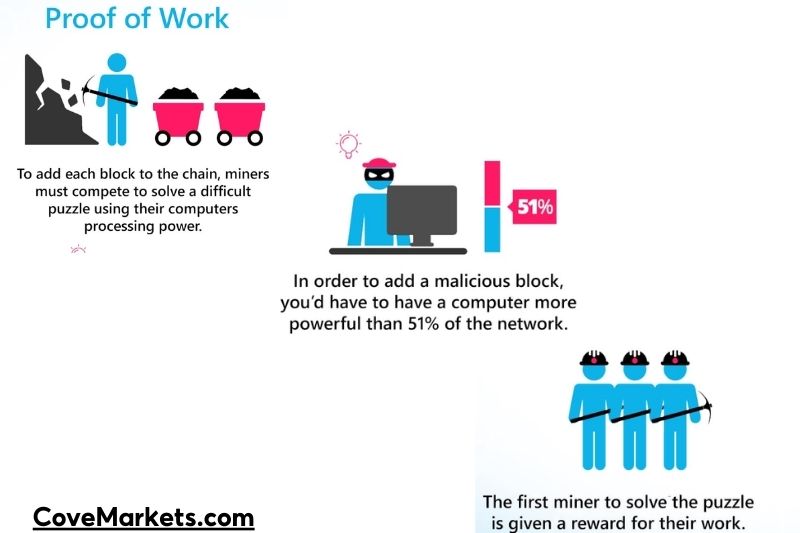
Proof of work necessitates an expensive computer calculation, or, in other words, the mining process. Mining is required in order to establish trustless transactions on the blockchain.
- Step 1 Transactions are assembled and grouped together into a block.
- Step 2 Miners then examine the transactions within each block to determine their legitimacy. To progress, miners must solve a mathematical conundrum called a proof of work problem. All miners must compete.
- Step 4 The miner who solves the first block problem is rewarded.
- Step 5 After that, the verified transactions are saved on the blockchain.
PoW vs PoS
Proof of Work Examples
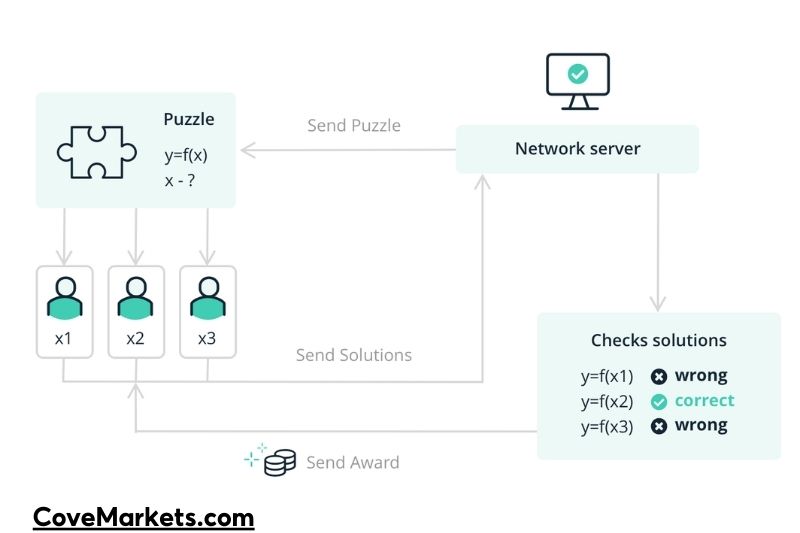
The proof of work paradigm has been around for a long time, so let’s look at some instances.
Emails
The first example will be emails that are attached to a large piece of text. Ordinary computers can send millions of emails each day, but doing other duties and receiving a large amount of spam can impair their performance and increase processing expenses. PoW is used to decrease processing cycles by presenting complex computing tasks that improve security.
Cryptocurrencies
Mining a cryptocurrency is one of the most well-known applications of PoW. The PoW mechanism assures that miners have direct network authority. It also prevents double-spending assaults from taking place. Because PoW includes enough headers in new blocks, miners have a fixed revenue.
DDoS
PoW is also used to migrate DDoS attacks that create inconvenience and disruption. The PoW algorithm finds a communal solution to hard mathematical problems. PoW aids in the distributed solution of problems. In this manner, even a small group of people can tackle complex problems.
Examples of Proof of Stake
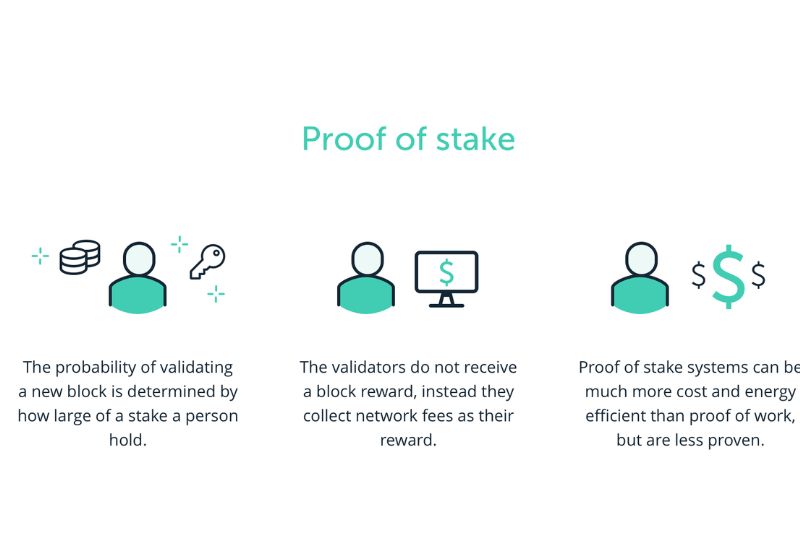
Proof of- Stake (PoS) is the ostensibly superior method of solving cryptography challenges. The coins listed below use the PoS methodology, which is faster and more secure than PoW.
Tezos
Tezos‘ decentralized network has an incentive system that pays validators. Validators accept freshly produced tokens in order to maintain and secure the network. As additional individuals join and become active in the network, the stakes rise. Tezos’ PoS technology also prevents manipulation with awards and blockchain data.
Ethereum 2.0
Vitalik Buterin, the co-founder of Ethereum, proposed the Ethereum Improvement Proposal in 2016. It employs Sharding, a modified variant of the PoW method. By storing more hash power, the Sharding concept can increase network performance. Additionally, Sharding would boost the number of transactions in a block.
Read more: Ethereum Vs Ripple: ETH Vs XRP. Which Crypto Is Better In 2023
Cosmos
Cosmos is often used for establishing a PoS network for wider use (more than Bitcoin). The project wants to become the largest PoS-based coin by acquiring millions of users. People who do not have access to the banking system are among its target demographic.
How are Transactions verified: PoW
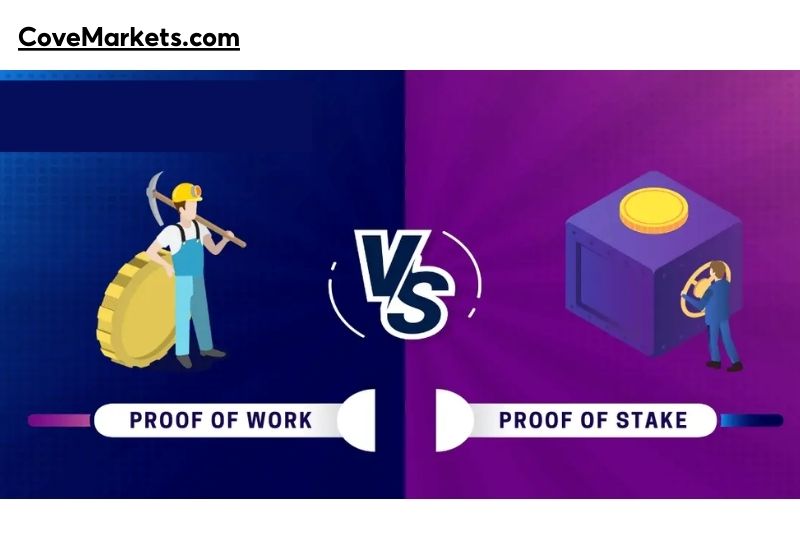
Without an example, it can be difficult to understand how transaction verifications function in PoW. Consider the Bitcoin model.
- Step 1. A new block is formed every 10 minutes or so. It takes roughly the same amount of time to validate Bitcoin transactions.
- Step 2. Each block contains several transactions that must be verified. Every transaction becomes complex and energy-consuming to verify in a decentralized system.
- Step 3. Proof-of-Work provides enormous processing capacity to solve the cryptographic algorithm. It prevents network users with fewer resources from receiving better benefits.
- Step 4. Once all transactions within a block have been validated, they are posted to the public blockchain and can be viewed by other users.
Consider the mathematical sum 4+8 using Proof of Work. We now know the answer is 12. However, in this paradigm, whoever finds the solution first receives the mining reward. Consider two miners competing to solve this problem. The outcomes would be as follows:
Miner 1
- Attempt 1: 4+8 = 11 *Incorrect*
- Attempt 2: 4+8 = 9 *Incorrect*
- Attempt 3: 4+8 = 10 *Incorrect*
Miner 2
- Attempt 1: 4+8 = 13 *Incorrect*
- Attempt 2: 4+8 = 12 *Correct*
- Attempt 3: 4+8 = 14 *Incorrect*
As you can see, miner two correctly answered the answer on the second try, earning the miner prize. However, computers can run millions of combinations every second.
At any given time, multiple hardware devices are attempting to solve cryptographic equations. It’s almost like a race to see who can cross the finish line first and collect the mining reward.
The procedure is slightly different in the case of any PoW coin other than Bitcoin, as is to be expected from second and even third-generation cryptocurrency initiatives created to address Bitcoin’s flaws.
How are Transactions Verified: PoS
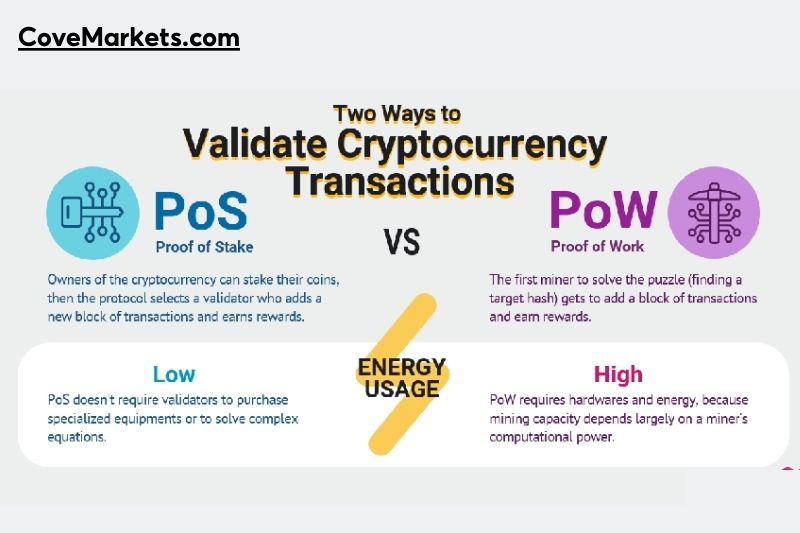
In comparison to the Proof of Work approach, the Proof of Stake consensus employs distinct mechanisms for transaction confirmation and consensus. While it similarly employs a cryptographic technique, the goal is very different.
In the instance of Proof of Stake (PoS), the next block is created based on how much an individual stake. The stake is determined by the number of coins a user has for the blockchain they are attempting to mine.
Technically, the players are “forging” rather than mining because there is no block reward to be obtained. Unlike Bitcoin, cryptocurrencies that use PoS reward participants by paying a transaction fee.
To start staking, users must first deposit funds into a specified wallet, which freezes the coins and allows them to be staked on the network. Most PoS blockchains have a minimum coin threshold to begin the staking process, which requires a significant initial commitment.
Example of PoS verification

Let’s look at Dash as an example of PoS verification (DASH). The minimum need is 1000 DASH, which would have been comparable to $1.5 million at one point (December 2017).
- Step 1 First, pick how many coins you want to stake to produce PoS rewards.
- Step 2 Determine the total amount of coins in circulation on the blockchain. In our case, there are 1000 coins in circulation.
- Step 3 You must next purchase and invest 100 coins, representing 10% of the currency in circulation.
- Step 4 You are now ready to get your staking rewards. According to this scenario, you have a 10% chance of receiving every prize on the blockchain.
When should PoW or PoS be used?

The consensus mechanism is critical to the distributed design of a blockchain network because it eliminates the centralization of the entities in charge of confirming transactions. To maintain the immutable, trustless, and distributed properties of a blockchain network, a full function of consensus mechanisms is required.
The types of consensus mechanism necessary are determined by the network’s requirements. For example, proof-of-work is necessary for a network for fraud prevention, security, and trust-building. Because of the security provided by PoW, miners (or independent data processors) cannot be misled about a transaction. Proof-of-work is a means of safeguarding a crypto asset’s transaction history while also increasing the difficulty of modifying data over time.
The requirement that a participating node demonstrates that the work has been done and submitted qualifies it to add new transferings to the blockchain, protecting against malicious behavior.
If there are multiple copies of the blockchain on the network, PoW assists in determining the most valid copy. Finally, proof-of-work is required for the creation of a distributed clock that allows miners to freely enter and quit the network while keeping a consistent operation rate.
Similarly, utilizing a PoS-based approach has substantial repercussions for network efficiency and security. PoS is used when high transaction speeds are necessary for on-chain transactions per second and actual network transfer settlement. Furthermore, validators are likely to own considerable quantities of the network token, which financially incentivizes them to maintain the chain secure.
Is Proof of Stake better than Proof of Work? Reasons Why

The Proof-of-Work paradigm has devolved into an unjust system in which ordinary participants have no chance of receiving mining rewards. However, this is not the case with proof-of-stake, where everyone has an equal potential to become a forger and get incentives.
Because of the benefits outlined above, Ethereum is ready to migrate to PoS in its 2.0 edition. The introduction of ETH 2.0 is scheduled for next year.
Ethereum developers and communities have always advocated for a decentralized and transparent ecosystem. Given how prospective hackers exploit the proof-of-work paradigm, it’s easy to see why Ethereum and other crypto projects prefer the proof-of-stake process.
FAQs

Is Ethereum PoW or PoS?
Ethereum, like Bitcoin, currently uses a consensus protocol called Proof-of-work (PoW). This allows the nodes of the Ethereum network to agree on the state of all information recorded on the Ethereum blockchain and prevents certain kinds of economic attacks.
Read more: Litecoin Vs Bitcoin Comparison: Which Should You Invest 2023?
Why is PoW slower than PoS?
The PoW speed can change and must be adjusted, which is easier with slower target speeds (time at which a new block is created). PoS is not worked (time) dependent and can provide a fixed and thus potentially faster, reliable block creation speed.
Is Bitcoin a PoS or PoW?
Proof-of-Work (PoW) is a mechanism Bitcoin uses to regulate the creation of blocks and the state of the blockchain. Proof-of-Work provides an objective way for all members of the Bitcoin network to agree on the state of the blockchain and all Bitcoin transactions.
Conclusion
There is no real difference between POW and POS, except that POW requires miners to use their computational power to validate transactions, while POS allows any node to confirm transactions. Both algorithms have their own advantages and disadvantages, but in general, POW is considered more secure, while POS is more scalable.
There are also a lot of alternatives to proof of work such as Proof of History, Proof of Elapsed Time and more.
Thank you for taking the time to read! Access our website CoveMarkets.com to learn more useful information
Disclaimer: The information provided in this article is not investment advice from Cove Markets. Cryptocurrency investment activities are yet to be recognized and protected by the laws in some countries. Cryptocurrencies always contain financial risks.
TOP 10 Best Blockchain Solutions & Its Use Cases In 2023: What Are The Benefits
BEP2 vs BEP20 vs ERC20: Which Is The Best Choice For You 2023?
Crypto Vs Stocks: Is It Better To Buy Crypto Or Stock? Full Guide 2023

